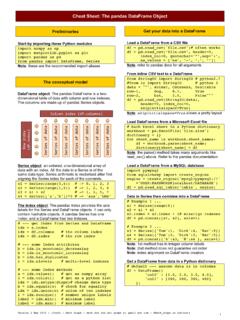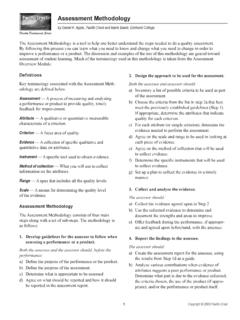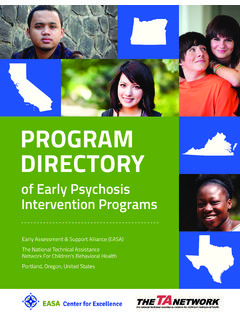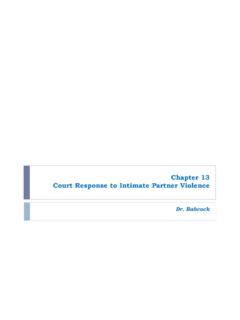Transcription of The Court Response to Intimate Partner Abuse Chapter 13
1 The Court Response to Intimate Partner Abuse Chapter 13. DR GINNA BABCOCK. Introduction With criminalization of domestic violence, lines between criminal and civil actions are blurring Protection and relief from domestic violence are both criminal and civil Domestic law located within federal and state Court jurisdictions Most frequent Court Response to IPV is requirement that offender attend a batterer treatment program Protection order and batterer treatment programs are two initiatives representing greatest change in Court procedure for DV cases Advocate Roles Advocates assist survivors by providing resources and support New initiatives with combined efforts of government and non-profits reflect
2 Increased protection and assistance for survivors who access the Court system Assist in applying for protections and resources, such as: Victim Services Victim Shelters Weapons Confiscation and Gun Ban Domestic Violence Advocates Victim assistance programs are located in law enforcement and prosecutors' offices State-run programs receive funding from various sources, including the federal government The services offered vary widely Advocates provide information about: legal rights and the criminal justice process, assistance in applying for state victim compensation aid, and referrals to social service agencies Victim Privacy Protections Survivors can request their name, telephone number, and address not to be made part of the public record when filing for a Court order of protection Referred to as Protection Order Confidentiality.
3 A standard procedure for those who fear for their safety Efforts being made at federal level to offer protection to victims who fear that personal information will be made available to an abuser The Driver Privacy Protection Act (18 U S 123 2721), effective on September 13, 1997 is one example Address Confidentiality programs Voter Registration Confidentiality programs Role of the Courts Prosecution of domestic violence cases is not exceptional or rare Prevalence of prosecution varies from one jurisdiction to another Average arrest prosecution rate is percent Jurisdictions with specialized domestic violence prosecution programs typically have the highest rates Not all cases filed by prosecutors got to trial Prosecution Outcomes 7 in 10 charges were aggravated assault or sexual assault One third of these felony assault charges were classified as
4 Domestic violence Domestic violence definition includes violence between family members, Intimate partners, and household cohabitants Domestic violence defendants were slightly more likely to be convicted and given longer sentences than non-domestic violence defendants Domestic less likely granted pre-trial release Specialized Prosecution Units Specialized units are key to successful prosecution Greater interagency collaboration between prosecutors, social service providers, victim advocates, and victims is one major benefit of the organization of specialized prosecution units Included in the units are attorneys and victim witness coordinators with special training and skills in obtaining evidence and prosecuting sexual predators and offenders who are batter Does Prosecution of Offenders Deter Re- Abuse ?
5 The key to deterrence is the disposition imposed Those who receive more intrusive sentences, including jail, work release, electronic monitoring, and/or probation, show significantly reduced re-arrest rates when compared with those who received less intrusive sentences of fines or suspended sentences without probation Other studies have shown conflicting results Court Jurisdiction network of courts across the United States makes up the judicial system Scope and authority of each Court is called its jurisdiction Constitutional or statutory parameters within which judicial power may be exercised limit the Court to a geographical area and to specific subject matter One group of courts in the system maintains federal jurisdiction District
6 Courts is also the name give to lower courts of the states Court Jurisdiction United States Supreme Court Highest Court in the nation; has power to choose cases it wishes to hear Cases are presented through appeals from lower federal courts and from state supreme courts on the interpretation of federal law or of the Constitution itself Opinions of the Courts provide precedent or guidelines for the states to follow Decisions of the Court become case law States cannot take away any citizen rights afforded by the U S Constitution as interpreted by the U S Supreme Court United States Court of Appeals Federal courts have jurisdiction over decisions of U S District Courts The country is broken down into areas
7 Referred to as circuits They hear appeals from the lower courts United States District Courts Federal laws alleged to have been violated will come before a U S District Court These courts have original jurisdiction in all matters of federal criminal law Domestic violence offenses committed after crossing a state line, for example, may be prosecuted here Federal Versus State Jurisdiction Until recently, domestic violence was not within federal jurisdiction Early attempts to criminalize domestic violence at the federal level failed to pass In the 1970's federal legislation was again proposed Family violence was exclusive of state courts Family Violence Prevention and Services Act, 1984.
8 Provides federal funding for victim services to the states Provides public education for family violence prevention Help states provide: Shelters, Education, Research, and Crime Victim Compensation for domestic violence The Victims of Crime Act, 1984. Another major funding source for victims, including family violence survivors Crime Victims Fund, established by the VOCA, receives millions of dollars annually from criminal fines, forfeited bail bonds, penalties, and special assessments collected by the U S. offices, courts, and prisons (Office for Victims of Crime, 2005). Under the USA Patriot Act (2001), the deposit of donations from private entities into the fund was also authorized Domestic violence continued to be under the exclusive criminal jurisdiction of the states until the 1990's The Violence Against Women Act, 1990.
9 Introduced for the first time in history legislation called for the federal prosecution of a person who travels across state lines and intentionally injures or sexually abuses spouse or Intimate Partner Reintroduced, some provisions were incorporated into the Violent Crime Control and Law Enforcement Act of 1994, referred to as Title IV of VAWA. States continue to legislate and control criminal and civil actions relative to domestic violence for the majority of cases Differences Between State Court and Federal Jurisdiction Domestic violence offenses have traditionally been state crimes State statutes and civil codes protect citizens within their jurisdiction New federal offenses make it unlawful to cross a state line to commit domestic violence crimes or to violate a protection order The full faith and credit provision of VAWA requires that foreign orders of protection be recognized and enforced in every state as if
10 They had originated in the jurisdiction of the offense Some states have responded with their own statutes to implement the requirement; others rely on the federal mandate Federal statutes prohibit domestic violence crimes on federal property Civil Versus Criminal Court in the State System Allegation of a criminal law violation can be tried in a Court of general jurisdiction at the state level Some states issue criminal protection orders Provisions for civil protection orders found in state codes Overlap between the criminal and civil law is inherent in family violence cases Traditionally, family courts of limited jurisdiction have handled relationship issues Concurrent jurisdiction.












